The Great Silence (1968)
Directed by: Sergio Corbucci
Written by: Bruno Corbucci, Mario Amendola, Sergio Corbucci
Starring: Frank Wolff, Jean-Louis Trintignant, Klaus Kinski, Vonetta McGee
AKA IL GRANDE SILENZIO
ITALY
RUNNING TIME: 106 mins
AVAILABLE ON BLU-RAY. NOW, from EUREKA ENTERTAINMENT
REVIEWED BY: Dr Lenera
MAJOR SPOILERS!
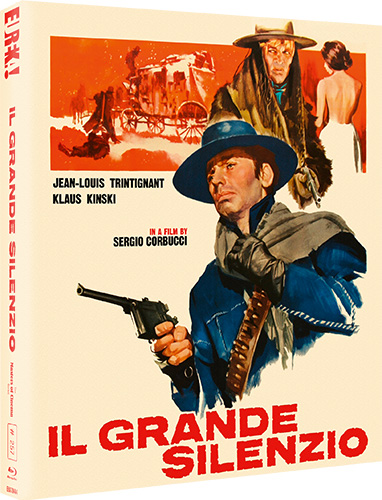
It’s 1898 in Utah and a severe blizzard has swept the area, bringing deprivation to the town of Snow Hill. As a result, much of the community is forced to steal in order to survive and are then branded outlaws. The most important man in town is Henry Pollicut, the corrupt justice of the peace who, seeking to make even more of a profit than normal, places prices on the thieves’ heads. Into this fraught situation come three men; Sheriff Gideon Burnett who’s been ordered to clean up the town, brutal bounty hunter Loco and his gang of killers who are attracted by the money that killing the outlaws will bring them, and Silence, a mute gunslinger who provokes enemies so he can shoot them in self-defense, and who shares a past with Pollicut. When Loco kills James Middleton, one of the thieves, his wife Pauline writes to Silence, requesting him to kill Loco….
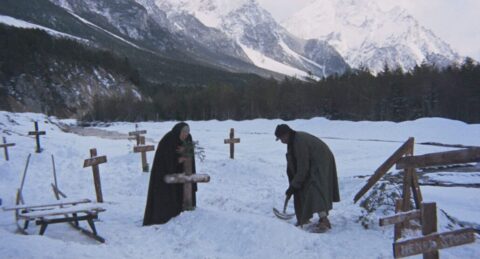
Though it may not seem the case because of the lateness of this review [apologies to Eureka Entertainment who sent this upon my request], I was very much looking forward to seeing The Great Silence again and reviewing it for two main reasons. The first is that I consider Sergio Corbucci’s film it to be one of the very best Italian westerns, up there with the greatest work of Sergio Leone and Sergio Sollima [the three Sergios really do form the Holy Trinity of the genre]; in fact I’d say that it’s a very fine western full stop. I think that the time has long gone that the Latin brand of oater was automatically considered to be inferior to its American counterpart. The second is that it’s a film that affected me greatly when I first saw it when it came to its conclusion – and here be spoilers! At the end, we have the hero about to be engaged in a gunfight duel with the villain – and then the hero loses, and partly because the villain cheats! When I watched this on Season 3 of BBC2’s Moviedrome series with Alex Cox I was 19 years of age and already something of a film nut with plenty of experience. Yet, having missed Cox’s introduction where he probably mentioned the ending, I was totally shocked and even upset by this conclusion, even though the film had been subverting genre conventions all the way through. Westerns just shouldn’t end this way! Of course seen with more mature eyes, one realises that this is how it had to end. Yet it’s a film which may be bleak, cynical and brutal but which certainly doesn’t certainly lack for soul. In fact, it’s a very heartfelt piece from Corbucci that isn’t so much reminding us that the good guys don’t always win, but that they can’t always win in what is a cruel and unjust world, a perhaps subtle but important difference.
The project’s genesis began when Marcello Mastroianni told Corbucci that he’d wanted to star in a western for some time, and said that he probably couldn’t play the lead role because he couldn’t speak English, though the character could be a mute. Corbucci was tiring of the genre, but, when French producer Robert Dorfmann approached him about a western to star Jean-Louis Trintignant, having been thwarted in setting his hit Django in the snow, he relished shooting the majority of a film in the Dolemites where he could also visit all the ski resorts. Trintignant didn’t speak English either, so he became mute. The familiar Elios Film town set in Rome was also used. Most of the scenes there were filmed at night so that the shaving cream used as snow looked more convincing, while for the daylight scenes, the set was swathed in fog to disguise the fact that the surrounding countryside had no snow. Co-star Klaus Kinski had an on-set affair with actress Sherene Miller during the shoot while his wife Brigitte and daughter Nastassja enjoyed sledding in the snow. He also said to actor Frank Wolff “I don’t want to work with a filthy Jew like you; I’m German and hate Jews.”. Wolff had to be restrained from strangling Kinski and refused to speak to him. Kinski later said that he insulted Wolff because he wanted to help him get into character. The script’s ending was a happy one, but Corbucci changed it to unhappy one late in the day; producers then asked for a happier ending which he deliberately made so ridiculous that it was never used. Despite getting released in some countries other than Italy, it failed to come out in the US or the UK. Rumours exist that distributors 2oth Century Fox failed to release it in the US because Clint Eastwood bought the rights so it could be remade with him as the lead; the truth was that studio head Daryl F. Zanuck simply hated it. It did do well in some countries but then virtually disappeared for over two decades.
The first shot is of, of course, snow, a lengthy pan eventually coming to a man hiding behind a bush. He’s one of three awaiting another on a horse, and here he comes, the camera finally pulling back to that we can see the awe-inspiring vista of mountains and forest behind him. The claustrophobic approach dominates throughout but every now and again the landscape is emphasised. The rider, who is of course Silence, shoots dead two of them. The remaining one surrenders, but Silence shoots his hands so that he’ll try to draw his gun and get shot, after which he can claim that he didn’t want to kill him but had to save his own life. Is this really our hero? Soon after an elderly lady says how he has a reputation for fighting on the side of good but the only reason he probably has that reputation is because he shoots dead more villains than good guys, and probably more by luck than intent. Dirty Harry did say five years later, “There’s nothing wrong with a little shooting, as long as the right people get shot”. However, because Silence is mute, he has a vulnerable quality There’s even more subversion in the character of his main opponent, Loco, who we first see bursting into a house with one of his men to shoot dead a fleeing man right in front of his mother. “I’m sorry but it’s our bread and butter, understand”?, Loco says to the lady. Loco then finds another man, lassos a rope around him and drags him along in the snow saying he’ll kill him until he tells him where his remaining bounty is – after which he shoots him anyway. The beginning of For A Few Dollars More, a film that this one sometimes riffs on, tells us that, “Where life had no value, death sometimes had it’s price. That is why the bounty killers appeared”. Here, the bounty killers [actually bounty hunters but never mind] may be on the side of the law but are despicable nasties.
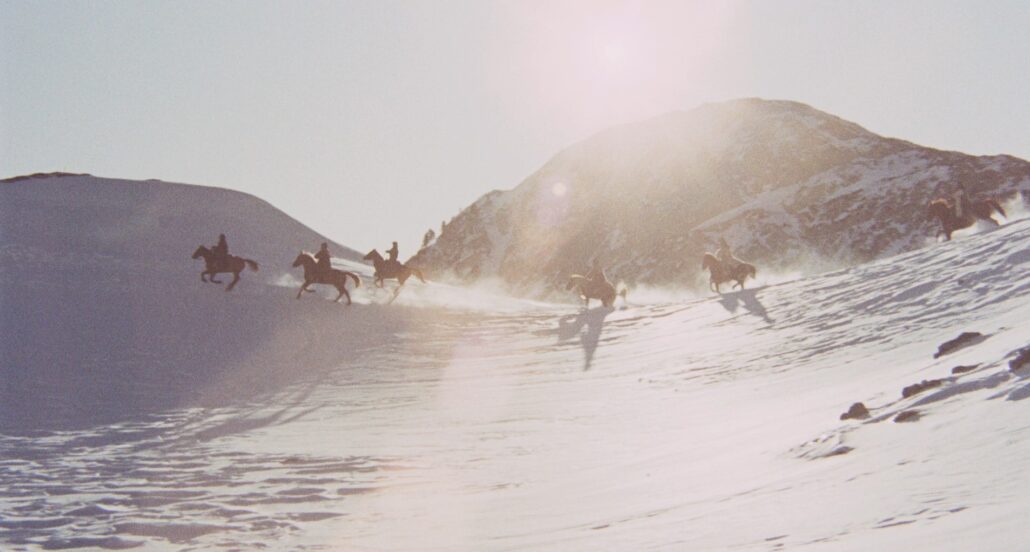
Silence is asked by the mother of the first victim of Loco that we see killed to rectify matters, but Silence is more interested in doing things like refusing to shut a door so that anyone objecting can try to draw their gun and be shot by him. Meanwhile, the newly-elected Governor, hoping to have order maintained before declaring an amnesty regarding the outlaws – though importantly an amnesty because he knows that’s what his electorate will want not because he believes it’s the right thing to do – assigns the righteous but bumbling soldier Gideon Burnett as the sheriff of Snow Hill. On his way, Burnett encounters the outlaws, but all they want is his horse because they have no food. In this film, the outlaws aren’t a threat and are the victims of a corrupt system and the murderous bounty killers. After getting lost in the snow, he finds a stagecoach travelling to Snow Hill where he meets Silence and then Loco. The three main characters will circle around each other throughout the film, watching, taunting [Silence even does the ‘throwing cigarette into someone’s drink’ thing that Clint did in the same year’s Hang ‘Em High, though humour is generally absent] and fighting as the situation gets worse around them and the tension increases masterfully despite action scenes being mostly short and to the point; no elaborate Leone-like setups here until the climax. Oh yes, the climax. The expected battle between the two main forces is reduced to virtually nothing, then the final confrontation is staged like a nightmarish variation on the death of Torrey scene in Shane. Poor Silence, despite having a semi-automatic gun which has previously given him an advantage over his opponents, barely has a chance. And then more good folk are shot. Audiences just weren’t ready for this even at a time where negative conclusions were becoming quite common, perhaps partly because, here, it’s the State that’s doing the killing.
Despite it being credited to four screenwriters – Vittoriano Petrilli, Mario Amendola, Bruno Corbucci and his brother Sergio himself – the script is very tight, economical and focused. Elements are interweaved into the narrative naturally, characters behave the way they probably. The main female interest is especially worthy of note. We first meet Pauline when Loco holds a gun to her head while calling out “I won’t shoot” to her husband. Of course we know by now that he’s not a man of his word. “What times we live in, a black’s worth as much as a white man” he says to himself after the event. Having an African-American leading lady [played by future Blaxploitation star Vonetta McGee] would have been a big deal in 1968, and Pauline’s no pushover either. She attempts to sell her house to the vile justice of the peace Pollicut, who demands that she becomes his mistress – his reason for putting a bounty on her husband. Pauline bitterly refuses but is willing to offer herself as payment to Silence if he’ll avenge her. While tending to his wounds, she seduces him anyway [I doubt he’d have ever taken the initiative, there’s only one thing he seems to be interested in] in a scene that seems very real and believable, the way that it’s done. Later on, she tries to get him not to leave by telling him that she loves him, but surely she can’t mean that? Then there are the two flashbacks, placed at very good points in the story, where we find out why Silence is the way that he is and what his connection with Pollicut is. The violence is sudden and bloody throughout this film, from thumbs being shot off to a face burned in a fire, but here, the nastiest moment is faded out before we see anything. We don’t need to.
The Man With No Name said little. Silence says nothing. Trintignant is required to do little more than react, often with just his eyes, to what others say in what’s a very subtle but detailed performance. Kinski often played the western villain, but seems to especially enjoy playing this one. We can see that Loco gets a real kick out of his ‘work’ yet he also believes that it’s justified. Kinski also puts in some delicate, almost effeminate, mannerisms which make his character even more interesting. Even the voice with which he’s dubbed into English works well. Familiar genre faces such as Luigi Pistilli, Frank Wolff, Spartaco Conversi and Carlo D’ Angelo fill out the cast and do some of their best work. The shooting style is quite rough in the Corbucci way, with lots of handheld camerawork and out of focus shots, and there’s even a lengthy shot where we can clearly a rope attached to a horse that we were clearly not meant to see. But then we also get lots of careful compositions. A favourite device is to shoot the faces of characters through windows so they seem trapped by the panes, as if they’re trapped by this horrible world, even the many villains. A candle from the present lingers when we cut to the past. Cinematographer Silvano Ippoliti likes to shoot throw things with mixed success. On some early shots a net that’s been put over the lens, probably to stop it from freezing, is very obvious, but many later shots that either diffuse the reflective parts of the snow or suggest a foggy mist work well in an almost phantasmagoric way.
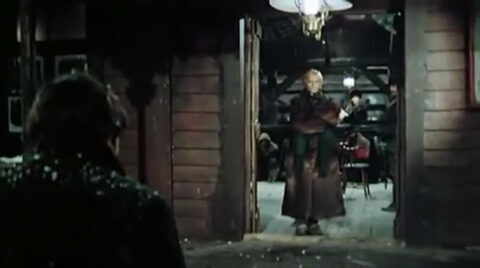
When composer Ennio Morricone died nearly a year and a half ago, the first piece of music I put on was his main theme for this film; its mournful sadness yet also muted sense of adventure seemed very appropriate. While he sometimes uses similar instrumentation to his other Italian western scores, the score is often more astringent and the tone darker. Even the piece that plays during the love scene has a hopeless quality to it. Many of its chord progressions would form the basis of a lot of later Morricone romantic themes. “Hopelessness” might be a good word to describe the essence of The Great Silence. One of the most interesting things about the Italian western is how it frequently depicted the supposed forces of law and order as being corrupt and evil, but none went as far as this film, which was nothing less than a deliberate commentary on how revolutionary figures of the time like Che Guevara, Martin Luther King and Malcolm X ended up being crushed by the system they were battling so hard against. The Great Silence reminds us that real heroism isn’t so much as winning but trying to do what’s right even if you’re probably going to lose.
SPECIAL FEATURES
Limited edition of 3000 units
Limited Edition O-Card slipcase
Limited Edition reversible poster featuring the film’s original artwork
Limited Edition set of 4 facsimile lobby cards
1080p presentation on Blu-ray from a 2K restoration
The Great Silence has never looked that great, probably because prints have just not been looked after well. We need to remember that it was almost a lost film for some time. Eureka have probably based their release on Film Movement’s Region A restoration but done a new encode. Early scenes show some minor print damage that was no doubt impossible to repair; thereafter the print is pretty clean and sharp with well defined skin tones and deep blacks. The grain level is very heavy which may distract some but it’s generally evenly distributed so I didn’t find this to be a problem. This is still probably the best the film has ever looked.
English and Italian audio options
I watched the English dub as that’s what I was was familiar with, plus even the Italian versions of these films usually employ dubbing. It’s a reasonably good dub of its kind. The Italian version plays under the commentary tracks so I was still able to do a bit of comparing. They did a lot of name changing and, while the plot wasn’t altered, the English version seems to suggest that most of the outlaws were being persecuted for practising some kind of religion, possibly Mormonism, though it’s never made explicit.
Optional English Subtitles
Brand new audio commentary with author Howard Hughes and filmmaker Richard Knew
While we don’t get the slightly shorter ‘Grindhouse’ version that’s on the German Region B Filmjuwelen/Al!ve release, Eureka have ported over all the special features from the Film Movement disc and added some new material of their own, resulting in quite a packed release. The first of the three talk tracks is a nice, genial, very appreciative track. Maybe there’s not as much background information as we may want, but I had to love a track where one of the participants says that he recorded the score off TV onto a cassette; I used to do exactly the same thing with unavailable or expensive film soundtracks that I liked! The pair do remind us that The Great Silence was very influential, point out the locations pointed to us [they did a great job of matching sets with real locales on this film, I barely noticed], and told me something important I’d honestly never picked up on before; that TV showing which made so many of us fans of this movie was cut, shortening some of the violence.
Brand new audio commentary by filmmaker Mike Siegel
I’d heard Siegel before, doing good commentary tracks for a couple of Sam Peckinpah films, so I was looking forward to hearing him here. His tracks is very different to the previous one, and therefore the two together achieve a really nice balance with very little repetition of material. He begins by saying that he’s not too fond of analysis; “explaining all, to me, never fully works”, which is fair enough I guess. He has enough to say anyway, even if he does go a lot into biographies in the second half- not that I minded hearing about Corbucci who’s not really spoken of much these days even though some of his work has been reappraised. He says that the German print was much darker and that this may have been due to censorship so the violence couldn’t be seen as well, addresses controversies surrounding the film such as the aspect ratio and Eastwood [we learn that Zanuck ordered the ending to be changed], and suggests that the net effect could be due to the lens not having been attached properly as this happened to him once.
Audio Commentary by director and Spaghetti Western aficionado Alex Cox, recorded live at the Hollywood Theatre, Portland, 2021
Being totally honest, there isn’t much here that isn’t covered in the other two tracks, though Cox does provide a few tidbits such as saying that the gun used by Silence was not made up but a real one called the Mauser Rolo that went on to be used by the Bolsheviks and dubbed the Bolo, that nobody is credited as editor [did Corbucci do the cutting?] though an assistant editor has their name up, and says the final word on the Eastwood issue from things he was told directly at the time; Eastwood was indeed interesting in starring in a remake and the release of The Great Silence in the US and the UK was indeed held up as a result, but by the distributors, not Eastwood, and things went no further. I’m quite a fan of Cox [and his films] so I still greatly enjoyed this track; he passionately expresses his love for this film but does wonder if the scene where Burnett is sent to Snow Hill is necessary
Alternate “Happy” Ending with optional Audio Commentary by filmmaker Alex Cox [2 mins]
So here it is, and it’s bloody awful. Aside from it not fitting the tone of the rest of the film, it has one character who we saw killed magically return from the grave, the even more magical disappearance of all that blood on Silence’s hand, and the revelation of a protective medieval gauntlet, followed by a cheesy wrap up. Cox has little time to say much, he doesn’t need to; we can see how bad it is.
Alternate “Ambiguous” Ending [4:31]
Now this isn’t too bad. It has a longer introduction to the actual shooting using deleted shots, shows the hand wounding, then shows the hostages going outside, before leaving us to guess what happens next. There’s a glimmer of hope here.
Brand new interview with Austin Fisher, author of Radical Frontiers in the Spaghetti Western: Politics, Violence and Popular Italian Cinema [14 mins]
Fisher’s main theme, very clearly expressed, is the film’s view of capitalism, with its inverted moral compass, beginning with telling us that this theme is no better shown than in the final shot. He also mentions the scene where a killer wears a sheriff’s badge before throwing it away as being important, and doubts that Michael Cimino sure it before he made Heaven’s Gate but notices many similarities.
Cox on Corbucci – filmmaker Alex Cox talks about Sergio Corbucci [15 mins]
Cox either lives in or owns a hut in the countryside. After retreating to said hut and putting on a poncho, he discusses Corbucci and this “heartfelt and distressing” masterwork. He says that it wasn’t Zanuck who wanted an altered ending despite Siegel saying to the contrary. He describes how Corbucci said how he disliked making westerns but when asked what his next film was, he replied “a western, naturally”. Cox overs Corbucci’s career and says he also was inspired by Yojimbo to make a western like Leone.
Western, Italian Style – 1968 documentary [38 mins]
Though basically a puff piece, this is still interesting to watch for genre fans, especially as it has some nice behind the scenes footage of the shooting of Run, Man, Run, One Dollar Too Many, Once Upon a Time in the West, Kill Them All and Come Back Alone, and of course The Great Silence. Frank Wolff provides a fairly witty narration in a documentary that looks at the explosion of Italian westerns at the time. We get to see the Corbucci interview mentioned by Cox as well as Sergio Sollima, but also an energetic Enzo Castellari choreographing a fight and saying that he doesn’t like to show graphic violence unlike most other genre directors; Chuck Connors, when asked what the differences are between Italian and American westerns, saying that the protagonists in these films are anti-heroes instead of pure heroes, and that punches and gunshots are far more plentiful; and Trintignant confessing that starring in a Spaghetti Western gives him a chance to do something outside of his established romantic persona. We also see a shed full of prop guns, extras eating and drinking on location, and several notable The Great Silence scenes being shot. The jaunty score by John Ireson and Wayne Parham, who we also see live in a club, gets a little irritating, but this is generally very worthwhile.
Promoting Silenzio [9 mins]
A re-edited version of the portions of Western, Italian Style that concern The Great Silence.
Silenzio in Pictures [6 mins]
A stills gallery.
Italian Theatrical Trailer [3 mins]
English Theatrical Trailer [3 mins]
Stills Galleries [24 mins]
A collector’s booklet featuring new writing by Western expert Howard Hughes
‘The Great Silence’ is a very unhappy film indeed, yet it’s also one of the masterworks of the Italian western. The terrific collection of special features just makes this release even more Highly Recommended.




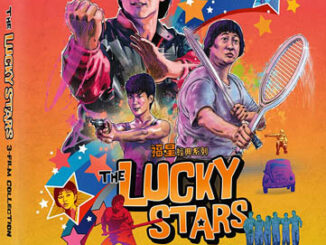


Be the first to comment